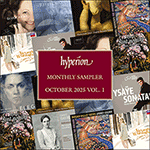
Welcome to Hyperion Records, a British classical label devoted to presenting high-quality recordings of music of all styles and from all periods from the twelfth century to the twenty-first.
Hyperion offers both CDs, and downloads in a number of formats. The site is also available in several languages.
Please use the dropdown buttons to set your preferred options, or use the checkbox to accept the defaults.
The part played by Joseph Szigeti (1892–1973) in instigating the composition of this set of sonatas is recognized in his being the dedicatee of the Sonata No 1 in G minor, the same key as the Bach sonata that inspired the enterprise. Szigeti was born in Budapest, made his debut in Berlin in 1905 and was greatly influenced by Busoni. In 1924, when these sonatas were published, he was coming to the end of a teaching post in Geneva and also gave the premiere of Prokofiev’s first Violin Concerto. Although he eschewed showmanship, retaining the old-fashioned habit of keeping his bowing elbow close in to the body, there was no questioning his technique or musical sensitivity, as this sonata amply demonstrates.
The opening Grave sets out the parameters of the whole collection: much double-, treble- and quadruple-stopping, often with one of the constituent notes to be accented; regular bursts of pseudo-Bach, often in chromatic vein; passages that seem to be excerpted from some book of exercises; and throughout, considerable fantasy in the joining of one idea to the next. This opening movement also concludes with a passage of tremolo sul ponticello—a ghostly mirage, gently dispelled by the final minor third. In the Fugato, an innocent, Bachian subject is put through its paces, sometimes hidden in the middle of triplets, and twice loudly proclaimed in sextuple-stopping. The indications amabile and scherzoso well describe the third movement in the relative major, B flat, which even copies Baroque practice in starting with an eight-bar section repeated. More intense figuration then blurs the dancing character before the opening tune returns. The Finale is a weighty gigue that relishes extreme contrasts of texture, with the opening G minor idea returning now both at the end and in the middle.
from notes by Roger Nichols © 2015
Le rôle joué par Joseph Szigeti (1892–1973) dans l’instigation de la composition de ce recueil de sonates lui valut d’être le dédicataire de la Sonate nº 1 en sol mineur, la même tonalité que la sonate de Bach qui inspira cette entreprise. Né à Budapest, Szigeti fit ses débuts à Berlin en 1905 et fut fortement influencé par Busoni. En 1924, lorsque ces sonates furent publiées, son poste d’enseignant à Genève touchait à sa fin et il donna aussi la création du Premier Concerto pour violon de Prokofiev. Même s’il n’avait pas le sens du spectacle, conservant l’habitude démodée de garder le coude de l’archet près du corps, on ne pouvait mettre en doute sa technique ou sa sensibilité musicale, comme le démontre amplement cette sonate.
Le Grave initial comporte les paramètres de tout le recueil: beaucoup de doubles, triples et quadruples cordes, souvent avec l’accentuation de l’une des notes constituantes; des poussées régulières de pseudo Bach, souvent dans une veine chromatique; des passages qui semblent tirés d’un livre d’exercices: et d’un bout à l’autre, beaucoup de fantaisie dans la jonction d’une idée à la suivante. Ce premier mouvement s’achève aussi sur un passage de tremolo sul ponticello—un mirage spectral, chassé doucement par la tierce mineur finale. Dans le Fugato, un sujet innocent à la manière de Bach est mis à l’épreuve, parfois caché au milieu de triolets, et proclamé haut et fort à deux reprises en sextuples cordes. Les indications amabile et scherzoso décrivent bien le troisième mouvement au relatif majeur, si bémol, qui copie même la pratique baroque en commençant par une section de huit mesures faisant l’objet d’une reprise. Une figuration plus intense brouille ensuite le caractère dansant avant le retour de la mélodie initiale. Le Finale est une gigue conséquente qui se délecte de contrastes extrêmes de texture, l’idée initiale en sol mineur revenant maintenant à la fin et au milieu.
extrait des notes rédigées par Roger Nichols © 2015
Français: Marie-Stella Pâris
Joseph Szigetis Bedeutung als Impulsgeber zur Komposition dieses Sonatenzyklus wird damit anerkannt, dass ihm die Sonate Nr. 1 in g-Moll gewidmet ist—dieselbe Tonart, in der auch jene inspirierende Bach-Sonate steht. Szigeti (1892–1973) wurde in Budapest geboren, machte 1905 in Berlin sein Debüt und war sehr von Busoni geprägt. Als die vorliegenden Sonaten 1924 veröffentlicht wurden, stand er kurz vor dem Ende einer Geigenprofessur in Genf und gab zudem die Premiere von Prokofjews Erstem Violinkonzert. Obwohl er Schaustellerei mied und die altmodische Angewohnheit beibehielt, den Ellbogen seines Bogenarms dicht am Körper zu halten, standen seine Technik und musikalische Sensibilität außer Frage—wie mit dieser Sonate zur Genüge demonstriert wird.
Das eröffnende Grave steckt die Parameter des gesamten Zyklus ab: es kommen viele Doppel- und Mehrfachgriffe vor, wobei oft einer der Töne zu akzentuieren ist; es erklingen regelmäßige Pseudo-Bach-Passagen, oft in chromatischer Manier; es treten Passagen auf, die aus einem Übungsbuch zu stammen scheinen; und durch das gesamte Stück hinweg macht sich ein beachtliches Maß an Phantasie bei den Übergängen von einer Idee zur nächsten bemerkbar. Dieser Eröffnungssatz endet ebenfalls mit einer tremolo sul ponticello-Passage—eine gespenstische Schimäre, die von der letzten kleinen Terz in sanfter Weise aufgelöst wird. Im Fugato wird ein unschuldiges Bach’sches Thema in die Mangel genommen, zuweilen in Triolen versteckt und zweimal laut in Sechsfachgriffen verkündet. Die Anweisungen amabile und scherzoso charakterisieren den dritten Satz in der Durparallele (B-Dur) treffend—hier wird sogar die barocke Praxis übernommen, wobei eine Einleitung von acht Takten wiederholt wird. Der Tanzcharakter wird dann von intensiveren Figurationen etwas verschleiert, bevor die Anfangsmelodie zurückkehrt. Das Finale ist eine gewichtige Gigue, die in extremen Struktur-Kontrasten schwelgt, wobei das Anfangsmotiv in g-Moll nun sowohl in der Mitte als auch am Ende wiederkehrt.
aus dem Begleittext von Roger Nichols © 2015
Deutsch: Viola Scheffel
 Ysaÿe: Sonatas for solo violin Ysaÿe: Sonatas for solo violinTreading confidently in the footsteps of her award-winning Bach Sonatas & Partitas for solo violin, Alina Ibragimova brings to Ysaÿe’s twentieth-century response to these seminal works astonishing tenderness and strident vigour in equal measure.» More |
 Ysaÿe: Sonatas for solo violin Ysaÿe: Sonatas for solo violinWritten in 1923, Eugène Ysaÿe’s sonatas represent a musical snapshot of a particularly rich moment in the evolution of violin playing. An acclaimed violinist himself, each of the sonatas was written for one of Ysaÿe’s contemporaries: Joseph Sziget ...» More |
 Hyperion sampler - October 2025 Vol. 1 Hyperion sampler - October 2025 Vol. 1 |

